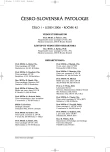Histologic Findings in Subantral Augmentation (Sinus Lift)
Histologické nálezy u subantrální augmentace (sinus lift)
Subantrální augmentace (sinus lift) slouží ke zvýšení množství alveolární kostní hmoty laterální maxily potřebné k ukotvení zubních implantátů. Jako augmentační materiál lze použít autogenní kost nebo různé cizorodé materiály, kterými lze autogenní kost do jisté míry nahradit. Autoři prezentují histologické nálezy ve vzorcích odebraných 9 měsíců po augmentační operaci za použití autogenní kosti, deproteinované bovinní kosti (Bio-Oss) a beta-trikalciumfosfátu (Cerasorb). Ve všech případech byly pozorovány známky kostní novotvorby v souvislosti s augmentačním materiálem. Nová kost se tvořila především na jeho povrchu; v případě Cerasorbu byly nalezeny trámečky novotvořené kosti i uvnitř porézních granulí. Ze zjištěných výsledků vyplývá, že hlavním mechanismem, kterým zkoumané augmentační materiály působily kostní novotvorbu, byla osteokondukce. Nepřítomnost obrovskobuněčné granulomatózní reakce a výraznějšího zánětu dokládá dobrou snášenlivost použitých materiálů.
Klíčová slova:
sinus lift – histologie – kostní novotvorba – autogenní kost – deproteinovaná bovinní kost – Bio-Oss – beta-trikalciumfosfát – Cerasorb
Authors:
A. Kohout 1; A. Šimůnek 2; D. Kopecká 2
Authors‘ workplace:
Fingerlandův ústav patologie LF UK a FN, Hradec Králové
1; Stomatologická klinika, FN a LF UK, Hradec Králové
2
Published in:
Čes.-slov. Patol., 42, 2006, No. 1, p. 29-33
Category:
Overview
Subantral augmentation (sinus lift) is used to increase alveolar bone mass of lateral maxilla in order to insert dental implants. In addition to the autogenous bone several foreign materials can be used for augmentation and they can replace the autogenous bone to some extent. Histological findings in specimens taken nine months after augmentation with the autogenous bone, deproteinised bovine bone (Bio-Oss) and beta-tricalcium phosphate (Cerasorb) are presented. In all cases a new bone formation around the augmentation material was seen. The new bone was deposited predominantly on its surface. In cases with Cerasorb the new bone formation was observed within the porous granules, too. From the obtained results it can be concluded, that the main osteogenetic mechanism in the examined augmentation materials was osteoconduction. The biocompatibility of the used augmentation materials was evidenced by an absence of giant cell granulomatous reaction and of marked inflammatory infiltrate.
Key words:
sinus lift – histology – new bone formation – autogenous bone – deproteinized bovine bone – Bio-Oss – beta-tricalcium phosphate – Cerasorb
Labels
Anatomical pathology Forensic medical examiner ToxicologyArticle was published in
Czecho-Slovak Pathology

2006 Issue 1
Most read in this issue
- Cervical Cancer Precursors: Cytohistologic Correlation with the Results of HPV Testing
- Pyloric Gland Adenoma – How to Diagnose?
- Isolated Lymphadenopathy as the First Presentation of Systemic Mastocytosis – Description of Two Cases
- Malignant Fibrous Histiocytoma of the Breast: Report of Two Cases
